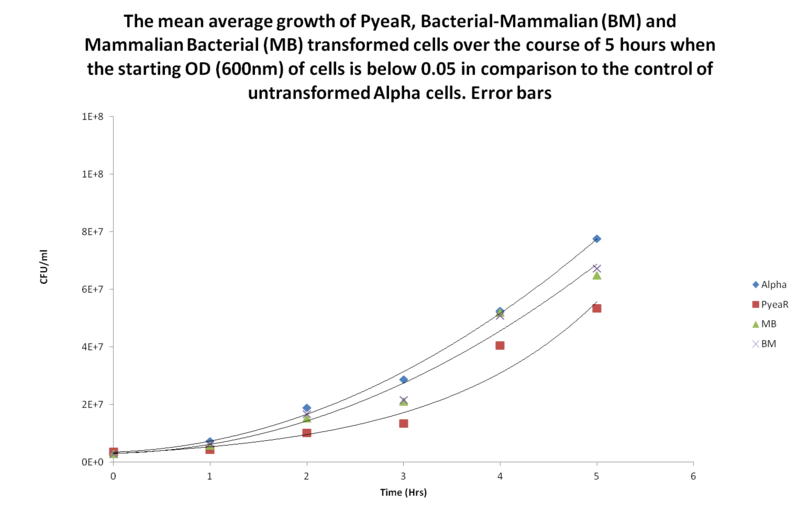Part:BBa_K774001
Contents
- 1 PyeaR + CArG nitric oxide, nitrate & nitrite-sensing hybrid 'Mammalian-Bacterial' promoter
- 1.1 Growth Studies
- 1.1.1 A comparison between the growth of E.coli cells, before and after transformation with the bacterial-mammalian promoter, as well as the mammalian-bacterial promoter (BBa_K774001) and PyeaR + GFP composite (BBa_K381001))
- 1.1.2 A comparison between the growth of E.coli cells, before and after transformation with PyeaR + GFP (BBa_K381001) and B-M and M-B (in pSB1C3)- Lag Phase Study
- 1.1 Growth Studies
PyeaR + CArG nitric oxide, nitrate & nitrite-sensing hybrid 'Mammalian-Bacterial' promoter
Growth Studies
A comparison between the growth of E.coli cells, before and after transformation with the bacterial-mammalian promoter, as well as the mammalian-bacterial promoter (BBa_K774001) and PyeaR + GFP composite (BBa_K381001))
The study involved testing the affects of transforming E.coli with different promoters on its growth over time. The promoters E.coli had been transformed with were PyeaR, M-B and B-M. These are promoters which all react to nitrogenous species. By running these together, we can obtain a direct comparison between all three of these promoters on the growth of E.coli. To see if there are any significant changes, the study was run alongside E.coli cells which had not been transformed with anything. For the rest of this brief report, untransformed cells will be referred to as Alpha cells and the other E.coli cells with transformations will be referred to as the promoter with which they were transformed with.
The E.coli cells used in the study and for the transformation are the same type of cells (Alpha select gold standard cells from Bioline). A colony was inoculated into 5ml of LB media overnight and the cells spun down the following morning and diluted with fresh LB until an OD reading at 600nm of 0.2 ± 0.01 was obtained. Three repeats were made of each sample.
The study lasted for 12 hours. An OD reading at 600nm was taken once an hour. Between the hour, the cuvettes were put into a 37ᵒC incubator to encourage growth and for standardising measurements with other growth studies. To calculate the number of cells in the samples, a calibration curve was set up. This involved using cultures of the E.coli cells without transformations. The E.coli cells were diluted with different volumes of LB and OD readings were taken as well as plating on Agar plates. After a day of growth, the numbers on these plates were counted and recorded. The CFU/ml was calculated. When the OD readings (x axis) and the CFU/ml (y axis) readings are plotted, the equation of the line of best fit, gives a conversion for the absorbance readings. This allowed us to measure the growth. This is demonstrated in figure 1.

Figure 1. Calibration curve to calculate the conversion factor between OD reading at 600nm and the number of colony forming units growing per ml (CFU/ml)
We found that there was a significant difference between Alpha cells and PyeaR cells. Initially, Alpha cells had a greater growth rate, but after the third hour into the study, the growth rate of PyeaR was faster than that of Alpha cells. The overall growth rate of PyeaR cells was significantly faster that Alpha cells (Levenes Test, F = 1.009 p = 0.372; T Test, t = 4.196, df = 4, p = 0.014).
Figure 2. Growth of PyeaR transformed E.coli cells relative to Alpha cells (untransformed cells). Error bars show the standard deviation between the three repeats. For clarity reasons, lines of best fit are not shown
The growth pattern and rate of E.coli cells with or without transformation with B-M and M-B show little difference. Any differences in growth rate were not significant. There was lots of overlap. As previously described, there was a significant difference between the growth rate of PyeaR and Alpha cells. There was also a significant difference between MB/BM and PyeaR cells. The statistical results can be seen in Table 1.

Figure 3.Growth over 12 hours of Alpha, M-B and B-M. Error bars and lines of best fit are not shown for clarity reasons.
Table 1. ANOVA readings of statistical differences between Alpha (1) PyeaR (2), MB (3) and BM (4).

From all the above graphs, it can be seen that with the starting concentration of cells as high as they are, the cultures are in exponential stage and do not undergo lag phase. A further growth study will be carried out on purely the lag phase with lower starting concentrations. As the starting absorbances here are approximately 0.2 at a wavelength of 600nm, the lag phase study will involve starting absorbances of 0.04 and lower.
A comparison between the growth of E.coli cells, before and after transformation with PyeaR + GFP (BBa_K381001) and B-M and M-B (in pSB1C3)- Lag Phase Study
Following the above study, we found that a lag phase only study needed to be carried out to see if there was a significant difference in the lag phase. Again the study protocol was the same except that the starting concentration absorbances at 600nm was lowered to <0.04. It was extremely difficult to keep the absorbances ranges within 0.005 so the range is actually 0.3±0.1. The below graph shows the mean average of all the data; using the data from the calibration curve, the absorbances were converted to colony forming units per ml (CFU/ml). The trend lines of alpha cells, BM/MB and PyeaR transformed cells are shown within this order from highest to lowest trendlines. One single trendline was used to represent BM and MB because the actual trendlines were extremely similar. Using the initial concentrations of 0.3±0.1 showed that there is little difference between the growth rates. Using statistical analysis, it was found that there was no significant difference between any of the transformed cells relative to Alpha cells or to each other (Anova, p > 0.05).
From this study we have found that changes in growth occur during exponential growth phase and not the lag growth phase.
| None |



